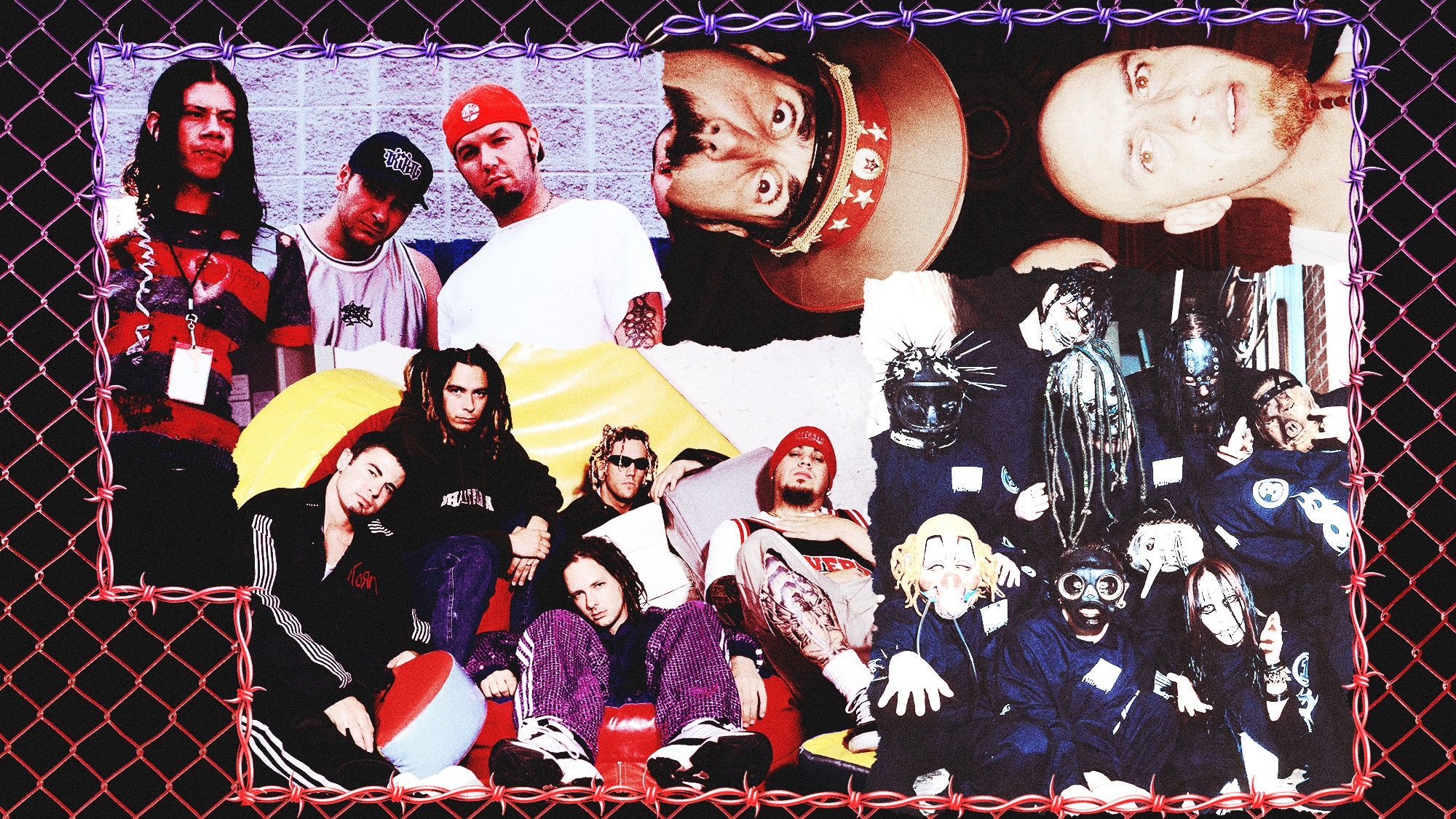After all the bizarre fashion collaborations we’ve seen over the past decade, I was convinced that nothing could surprise me anymore. And then, in late October, I learned that the nu metal band Korn—yes, the Freaks on a Leash themselves—had linked up with Adidas on a full-fledged capsule of apparel and footwear, including a tracksuit riddled with shiny purple sequins. To celebrate the collab’s release, the German sportswear giant even turned its Los Angeles flagship store into a temporary Korn exhibition—and just days after the drop, Adidas announced the collection had completely sold out. This was just the latest in a mounting pile of evidence that nu metal is more than merely relevant again. The genre is now something it’s never been before, even in its 2000s heyday: fashionable.
"The nu metal aesthetic feels like the alt version of the ’90s and early-aughts aesthetics that have been popular as of late, that have generally leaned more [towards] Paris Hilton party girl," said Sarah Rozansky, head creative at DONEGER I TOBE, a fashion consultancy that specializes in trend forecasting. "Gen Z seems to be gravitating towards this darker aesthetic that marries back to a niche music community.”
Adidas obviously did their market research: According to Google Trends, interest in nu metal is now higher than when they started tracking in 2004. The Y2K rock subgenre—associated with the likes of Korn, Limp Bizkit, Slipknot, Linkin Park, Deftones, System of a Down, Mudvayne, and Coal Chamber (most of whom ironically never identified with the “nu metal” label)—is as famous for its fusion of metal with pop and hip hop as it is for being deplored by critics. “It sucks that we all had to live through the dumbest trend in music history the first time, and it sucks even worse that we're being subjected to it again,” said Dan Ozzi, the veteran music writer and Sellout author, of nu metal's re-entry into pop cultural discourse.
Nu metal's resurgence has been percolating since the late 2010s, thanks to a generation of Soundcloud rappers and hyperpop artists allured by its lasting taboo. 100 Gecs, Poppy, Pink Pantheress, and Rico Nasty have all acknowledged nu metal as a musical influence, and the genre’s aesthetic legacy lives on in the horrorcore-inspired visuals of Playboi Carti, Doja Cat, and Trippie Redd. Longtime nu metal ambassador Lil Uzi Vert even released a cover of System of a Down's "Chop Suey!" on their recent album The Pink Tape. Sped-up remixes of tracks by bands like Deftones have helped transform nu metal into somewhat of a social media phenomenon on TikTok, particularly among young women. The brand Heaven by Marc Jacobs capitalized on this in March by releasing an extensive collaboration with the band. The genre also had a memorable presence on the soundtrack of Beef—one of 2023’s most popular Netflix shows—while Sick New World, a nu metal festival in Las Vegas, completely sold out in its inaugural year.
While rock subgenres like punk, goth, and grunge bring immediate signifiers to mind, what constitutes nu metal fashion is slightly murkier. It does, however, have its distinguishing attributes––namely the fusion of traditional rock styles with sportswear, alongside influences from skateboarding, hip hop and rave culture. Think outrageous hair (frosted tips, colored dreads), impractical piercings, chains, mesh, and fur, blended with Adidas tracksuits, oversized sweats, chunky skate shoes, white tanks, gas station sunglasses, and massive pants by JNCO or Tripp NYC. Nu metal style isn't a monolith, but it often leaned toward dirty, chaotic graphics and a more relaxed, slack-chic take on alternative style. Many of these bands were known for signature looks, like Mudvayne's cyberpunk face makeup, Coal Chamber's outrageous braids, Slipknot's boiler suits and masks, Korn's customized Adidas and skirts, and Limp Bizkit’s backwards hats and khakis.
There are countless examples of early adopters of this look, like Billie Eilish, Justin Bieber (who made headlines for wearing JNCOs this summer), Machine Gun Kelly and NBA star Jordan Clarkson. Nu metal has also carved its way into the luxury sphere. My guess is that the filmmakers who made the competing documentaries about Woodstock 99 didn't expect to end up on high-fashion mood boards, but Balenciaga's infamous Spring 2023 show bore a curious resemblance to scenes from the catastrophic nu metal festival—mud pits, wallet chains, and all. The nu metal agenda is equally alive and well in recent collections by buzzy labels like Vetements, 017 Alyx 9SM, Willy Chavarria, Diesel, Y-Project, and No Faith. "We're seeing a hardening of fashion aesthetics and a lot of darker tones and ugly color combinations," said Gwyneth Holland, a trend analyst at BDA London. "There is a move toward anti-cool and post-perfection, which is about embracing things that are gross or weird. I personally love that people are challenging old ideas of good taste. Nu metal is like a counter-trend to quiet luxury."
In July, Travis Scott sported Limp Bizkit merch on Instagram and in his music video for "K-POP" with The Weeknd and Bad Bunny. His Utopia tour merch, which broke sales records, also looks remarkably Korn-y. Nu metal-inspired looks also lend themselves well to meme-able moments: Consider Sam Smith in a full Vetements look at the Barbie premiere, or even Robert Pattison's GQ cover last year. Brands like Praying and Barragán—famous for their provocative shirts adorned with phrases like "Feral" or "J'Adore Ur Hole"—bring to mind the boldness and crassness of nu metal bands and their merch (like Slipknot’s infamous “people = shit” shirt). After all, “trashion” and controversy––two things nu metal bands have always understood and mastered––are pillars of the sartorial zeitgeist in the age of algorithms. Holiday Kirk, a music journalist and the admin of the popular X account @numetal_moment, offered his take: “I’ve been perturbed lately that the music is getting a bit lost, suddenly it feels like more of a fashion thing. But of course, that’s part of the reason why these bands were so successful. They were like content farms before that concept even existed.”
Instagram content
This content can also be viewed on the site it originates from.
The continuous churn of nostalgia-driven trends online has created a constant demand for looks and concepts that are more and more extreme. Nu metal's association among critics with crudity, violence, white male rage and general bad taste gives it an edge of provocation that genres like grunge and hip hop have long lost. On the surface, nu metal is the perfect amalgamation of aesthetics that are timelessly cool (metal, skateboarding, streetwear) and trendy (Y2K, rave). Its deeper cultural associations reflect the nihilism that has flourished among post-pandemic, post-woke mindsets.
Is it really so surprising that people navigating life on a war-torn and decaying planet are resonating more with the brutal simplicity and absurdity of “Break Stuff” than they are the heady, textural soundscapes of Pink Floyd? "People are trying to negotiate the endlessly awful and scary world we live in and that has morphed into a darker sense of humor," said Holland. "Compared with other rock forms, nu metal didn't take itself terribly seriously. I think that's part of why it appeals to people right now.”
Ross Robinson, who produced early records by Korn, Limp Bizkit and Slipknot, said this indifference to public opinion is what made nu metal so effective. "We had no idea anybody would care, outside of us,” he said. “There was nobody to impress, nobody to sell to." This attitude, particularly when translated in fashion, encapsulates a rare form of luxury. "More so than fashion, nu metal represents open emotion that had never been expressed in music before on that level. That, to me, is the most groundbreaking aspect of the genre,” Robinson added.
The ability to ruffle feathers has long been where the venn diagram of alternative fashion, music, and youth culture overlap. If music writers like Ozzi didn't consider nu metal to be the "dumbest music trend of all time," collaborations like Korn x Adidas would have no mystique. To quote one of Praying's best-selling T-shirts: “They don't build statues of critics.”
Thanks to ‘Saltburn’ and Gen Z's obsession with Y2K style, the nu metal staple is back in a big way.







